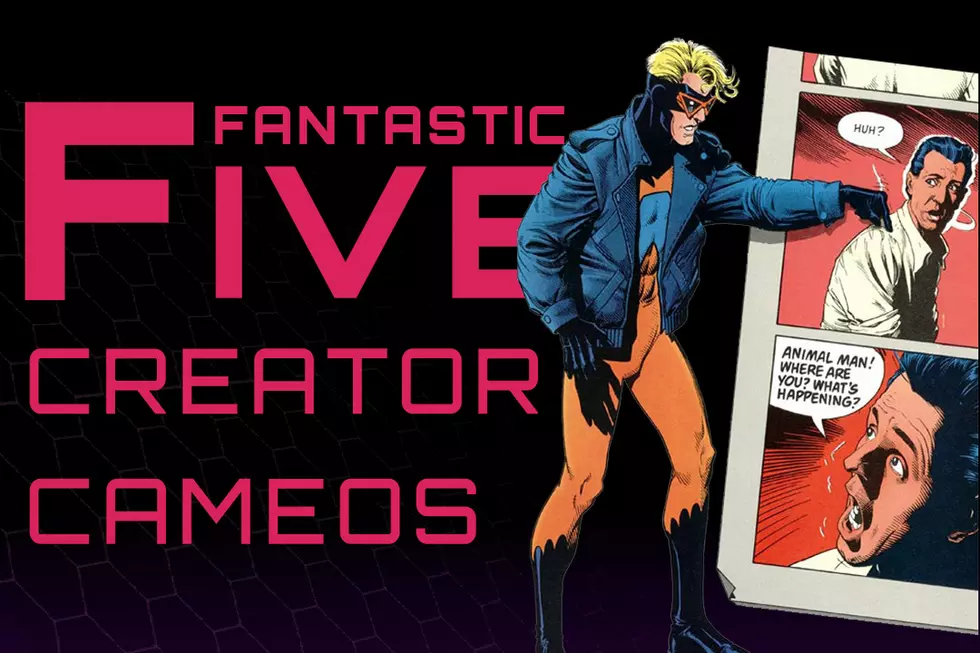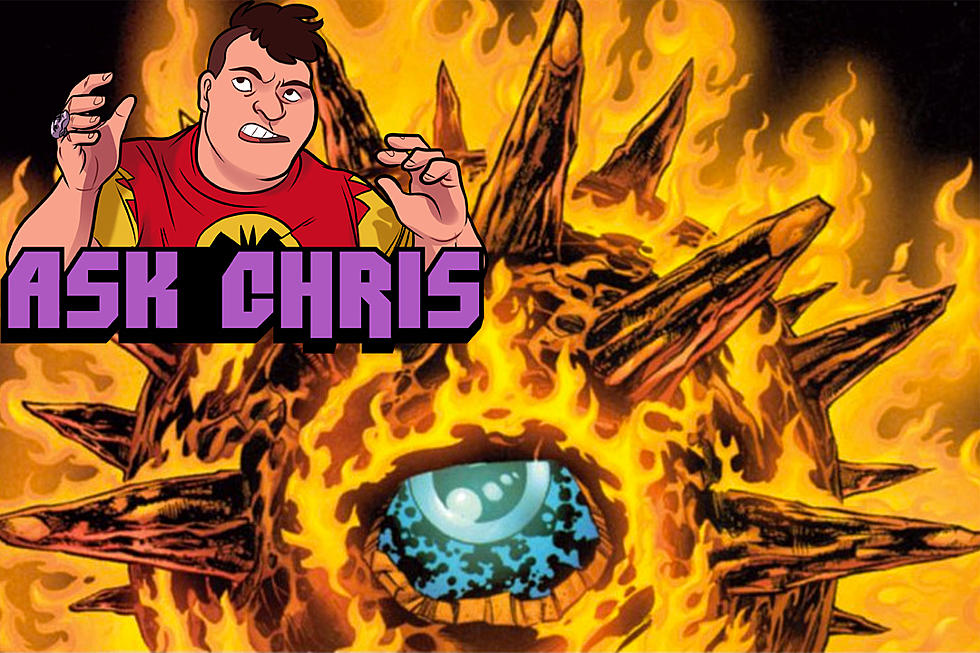
Ask Chris #215: Klarion The Witch Boy And The Kirby Approach To Horror
Q: The new Klarion series started this week, and aside from Seven Soldiers and Batman: the Animated Series, I know little about him. What's his deal? -- @T_Lawson
A: Huh. Well this one oughtta be pretty easy, T: He's a Witch Boy. He's a Boy who is also a Witch. That's pretty much all there is to it; Kirby wasn't really all that into subtlety. Now who wants to go get lunch?
[Editor's Note: Chris, we've talked about this.]
Okay, fine. There actually is a little more to it than that, but to be honest, Klarion is less interesting to me on his own than he is in the context of Kirby's other work. He's a Witch Boy, a strange and sinister creature rooted completely in horror, happily existing in a world built for superheroes, and that's actually pretty cool.
Of all the genres that Kirby worked in over his considerable career, which included inventing romance comics with Joe Simon, reinventing superheroes with Stan Lee, and dabbling in sci-fi, crime, and even autobiographical stuff, horror comics always felt to me like they were the weirdest fit for him. The traditional horror comic elements that all filtered down through the EC formula -- the ironic twists, the gruesome violence and the cynical inevitability of it all -- weren't things that Kirby's work was particularly known for. I mean, yes, Kirby was pretty great at drawing violence, but OMAC punching out seven men with one punch is on a level that's pretty far removed from someone holding up a severed head and a bloody axe, the infamous cover that got Bill Gaines called up to testify before the actual United States Senate.
That said, it's not like Kirby couldn't do scary stuff. He's actually responsible for my pick for one of the most genuinely frightening and disturbing moments in superhero comic history: Happyland, Darkseid's torturous amusement park from Forever People #4:
The idea is about as simple as you can get: A massive torture chamber disguised as an amusement park, with the victims hidden behind a cheerfully Plasticine facade. The genius is in the little tweaks that are added in, like the idea that the people being imprisoned and tortured can see the smiling faces of the other amusement park patrons as they drift by, or that Darkseid allows children, who are being brought along by adults for what's meant to be a happy day out, to see exactly what's going on there for no other reason than his own amusement.
Still, while that's creepy as all get-out, I'd never go as far as calling Forever People a horror book, even for one issue, simply because of the context of what's going on. It's like the "problem" with Hellboy that I mentioned last week in the Top Five videos: As good as Mike Mignola is at creating a moody, terrifying atmosphere, it's really difficult to actually be scared for Hellboy himself, because so many of those stories are built around the (literal) punchline of Hellboy socking whatever you're afraid of in the mouth and being done with it. What's amazing is that he (and the team behind BPRD) are actually able to pull it off, and in case you missed the dedication in the first volume, that's kind of a trick Mignola learned from Kirby.
Not to dive into even more hero-worship of Jack Kirby than I usually do, but I think what it comes down to is that Kirby wasn't scared by monsters. I remember reading a line in something Mark Evanier, I believe, wrote about Kirby that mentioned that for his entire life he had two recurring nightmares, one about being back in the war, and the other about being in poverty and being unable to provide for his family.
When you read his comics, that makes perfect sense. When Kirby went to fight in Germany, he told his superiors he could draw, and so they sent him to the front lines with a pencil so he could draw maps. I imagine that's an experience that changes one's priorities considerably. This isn't a dude who's afraid of getting slashed up by Freddy or Jason, this is a dude who's afraid of the horrors of war, of the idea that people could give into the dark sides of their personality and stop caring about what happened to the people around them, and he was writing and drawing two comics every month to talk about it. And while that makes for a grand, operatic superhero story, it doesn't really lend itself to the usual horror comic.
Until it did. Which brings us, at long last, to The Demon.
I love The Demon. It's one of my favorite Kirby books, because of how strange he got with it -- and considering the other comics that Kirby was producing in the '70s, that's saying something. But still, it doesn't quite fit into "horror" so much as "weird adventures." When you get right down to it, it's really just a superhero book dressed up with a little mysticism.
Don't get me wrong, there's some great, terrifying imagery thrown in there...
...but it's also a book where a monster in a cape fights dudes with names like "Baron Von Evilstein." I wasn't kidding when I said that subtlety wasn't really Kirby's thing. It's like Castlevania in a way: There's plenty of stuff that's certainly themed around horror and meant to be frightening, but you're never actually scared.
But that sort of changes when Klarion shows up. Right from the start, he's creepy, and it's largely because Kirby tells us nothing about him other than that he's a Witch Boy and that he has a cat. Everything else -- where he came from, what his true motivations are, even how he knows Jason Blood and Etrigan -- is left a complete mystery. And the weird thing is that he's treated like a villain -- and seems like a villain -- even though the first thing he does is help our hero out, and the second thing he does is call him for help when he's in danger of being killed by a bad guy. Everything about the setup is written like he's a new ally, but there's just something... off.
The idea of the Creepy Kid is a pretty old one, and that's exactly what Klarion is. The thing is, there's no twist to it, nothing that sets him apart or retrofits him into a superhero universe. He's just this creepy thing that looks like a child but has powers that no child should have, hanging out and looking vaguely sinister while the superheroes are growing increasingly uncomfortable about dealing with this character who's clearly from another genre.
At the end of that story, after Klarion proves that he can control the Demon, and mentions getting his help to take out some vague group of "elders," Etrigan takes exactly half a page to exile him to Somewhere Else, vanishing him in a puff of smoke to "a safe and distant place where Klarion can do no harm"; something that seems more and more ominous every time I read it. And it only gets even more ominous when Klarion shows up two issues later, all smiles, waking Jason Blood up from a nightmare and casually mentioning that in that "distant place," he found Others who taught him how to come back.
And then he promptly starts raising the dead.
As you can probably imagine, Klarion feels a lot more villainous in his second appearance, which makes sense given that he now has a personal vendetta against the Demon. It's here that he's really fully formed, and we learn a little more about Teekl too, when she turns from a cat into something that's almost but not quite human. It's never stated, but we start to get the sense that, while he has this level of power that makes it clear that he's not really a child, he has all the worst parts of a child's personality. He's capricious and self-interested, and willing to destroy anything in his way without thinking twice, because it doesn't even occur to him that it's a bad idea. What starts off as a sort of innocent cruelty has been honed into active malice, paired with the power to do anything.
Like, say, turn you into a tree on a whim.
That's where he's remained ever since, at least as a villain: This odd little being with unfathomable power and a pronounced mean streak, whose only motivations are entirely his own. He's a slightly more sinister version of Mr. Mxyzptlk in that regard. There was a while there where his (Witch) Boy status saw him relegated to dealing with the junior heroes of the DC Universe, like that Young Justice crossover, Sins of Youth, where he flipped the ages of the JLA and their sidekicks, and insisted that his name be accompanied with a musical sting because Peter David thinks stuff like that is hilarious.
Obviously he's tweaked a little as a protagonist, but as a villain, that's how I think he works best: Something weird and strange and unsettling that just doesn't belong in a superhero universe, something that gets rejected outright because it just shouldn't be here, and then keeps coming back to show you how right those instincts were.
Ask Chris art by Erica Henderson. If you’ve got a question you’d like to see Chris tackle in a future column, just send it to @theisb on Twitter with the hashtag #AskChris.
More From ComicsAlliance




![Super7 ReAnimates Alien and Predator, Masters More of the Universe [Toy Fair 2017]](http://townsquare.media/site/622/files/2017/02/IMG_2000.jpg?w=980&q=75)

![The Wild, Tear-Filled World of Heartbreak: The Best Romance Comic Covers Ever [Love & Sex Week]](http://townsquare.media/site/622/files/2017/02/featured1.png?w=980&q=75)


